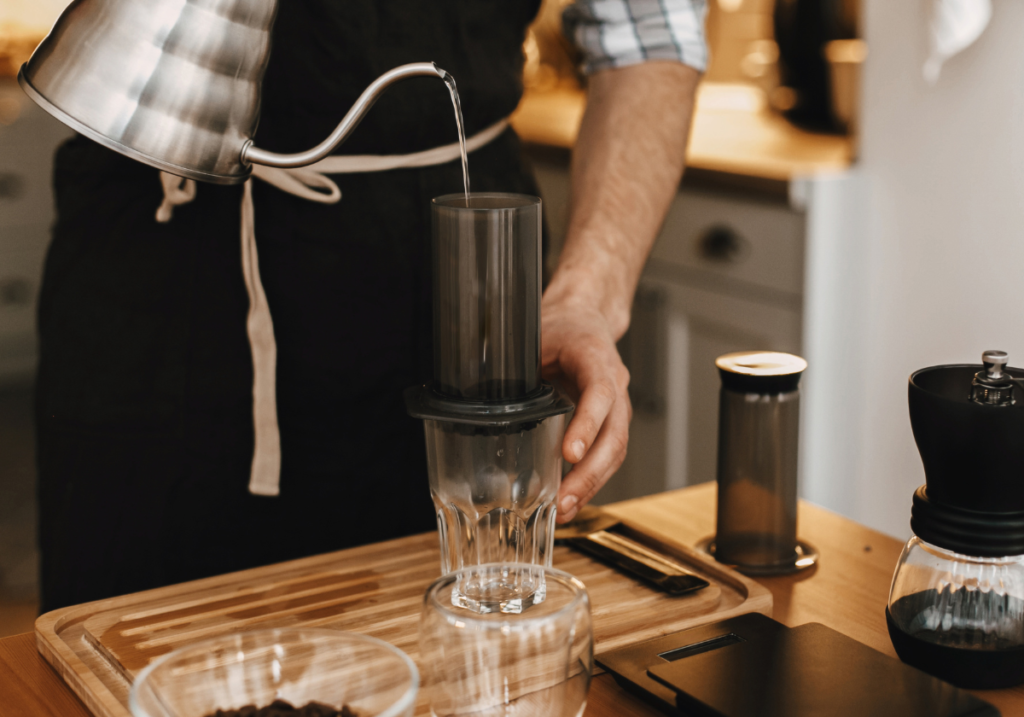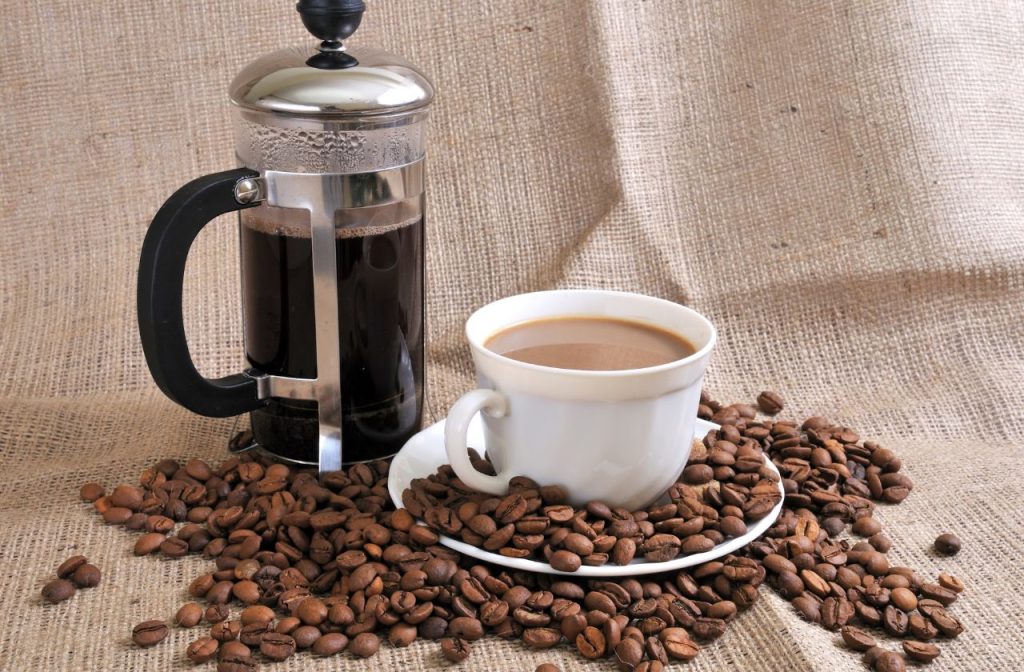9 Key Differences: AeroPress Vs. French Press Brewing
The AeroPress and the French press stand apart with their unique features and advantages when it comes to convenience for coffee brewing. These two methods offer distinct brewing processes, extraction techniques, flavor profiles, and portability options. By exploring the nine key differences between the AeroPress and French press, coffee enthusiasts can gain valuable insights to enhance their brewing skills and elevate their coffee experience.
There are significant differences that influence the coffee brewed with the AeroPress and French press methods. Brewing method, brew time, grind size, coffee extraction, taste and body, portability, ease of use, filter type, and serving size are different for each method.
By understanding these key differences between the AeroPress and French press, coffee enthusiasts can make informed decisions based on their preferences and brewing goals. Whether you prefer a cleaner cup of coffee with the convenience of portability or a full-bodied brew with a rich flavor, both methods offer their own unique benefits. Ultimately, the choice between the AeroPress and French press comes down to personal taste, convenience, and the brewing experience one seeks to achieve.
Weird Coffee Tip: The coffee used for French Press coffee brewing can make a difference to the flavor and body of the final outcome. Read our article on the topic to find out all the information!
Best Coffee For French Press
Key Takeaways
- The AeroPress has a shorter brew time compared to the French press.
- The flavor profile of coffee brewed with the AeroPress is cleaner and more refined, while the French press produces a full-bodied and robust flavor.
- The AeroPress is compact and portable, making it ideal for travel, while the French press is bulkier and better suited for home use.
- The AeroPress is made of durable materials and requires fewer accessories and maintenance compared to the French press.
What Are The Differences Between French Press And AeroPress?

First and foremost, let’s discuss the brewing process. The Aeropress utilizes a combination of immersion and pressure to extract the coffee’s flavors. It involves steeping the coffee grounds in hot water before using air pressure to push the brewed coffee through a filter. The French press relies solely on immersion brewing. The coffee grounds are steeped in hot water for a specific duration, and then a plunger with a mesh filter is used to separate the brewed coffee from the grounds. These distinct brewing techniques result in different taste profiles and body characteristics.
Speaking of flavor, the extraction methods employed by the AeroPress and French press contribute to their unique taste profiles. The AeroPress tends to produce a cleaner and smoother cup of coffee due to its paper filter, which removes sediment and oils. In contrast, the French press produces a full-bodied brew with more oils and sediment, resulting in a rich and robust flavor. The choice between a cleaner or fuller-bodied cup of coffee depends on personal preference and desired taste experience.
Another important aspect to consider is portability. The AeroPress is known for its compact and travel-friendly design, making it a popular choice for coffee enthusiasts on the go. It is lightweight and easy to pack, allowing coffee lovers to enjoy a quality brew wherever they may be. The French press is bulkier and less portable, making it more suitable for home use or situations where portability is not a priority.
1. Aeropress Vs. French Press: Brew Time

- French Press: Requires a longer brew time, typically 4-5 minutes, allowing for a full immersion of coffee grounds.
- AeroPress: Yields a quicker brew, usually around 1-2 minutes, due to the pressure-assisted extraction.
The brew time for the AeroPress and French Press methods differ significantly. Understanding the factors that affect brew time in these two brewing methods is crucial for achieving the desired flavor and strength in your coffee.
In the French Press method, the extraction rate is relatively slower compared to the AeroPress. This is due to the immersion brewing process used in the French Press, where coffee grounds are fully submerged in hot water for a longer period of time. The recommended brewing time for French Press is typically around 4 to 5 minutes.
The AeroPress method utilizes a faster brewing process. The pressure applied during the brewing process in AeroPress results in a quicker extraction rate. The coffee grounds are steeped in water for a shorter duration, usually around 1 to 2 minutes. This shorter brewing time is achieved by applying pressure to force the water through a filter and into the cup.
The difference in brewing time between the French Press and AeroPress methods has implications for the flavor profile of the resulting coffee. The longer brewing time in French Press allows for a more robust and full-bodied cup of coffee with a higher extraction rate. The shorter brewing time in AeroPress results in a cleaner and brighter flavor with a lower extraction rate.
2. AeroPress Vs. French Press: Brewing Method

- French Press: Operates on the immersion brewing method where coffee grounds steep in hot water, separated by a metal mesh filter.
- AeroPress: Utilizes a combination of immersion and pressure, pushing water through a filter to extract flavors quickly.
To continue the comparison between the AeroPress and French Press brewing methods, it is important to discuss the process of brewing. While both methods aim to extract flavor from coffee grounds, they differ in terms of equipment, brewing temperature, and overall technique.
Here are the key differences:
- AeroPress Vs French Press: Equipment comparison. The AeroPress requires a specific device consisting of a chamber, plunger, and filter, whereas the French Press is a simple glass or stainless steel container with a plunger and mesh filter. The AeroPress is compact and portable, making it ideal for travel or single servings, while the French Press is better suited for larger quantities.
- AeroPress Vs French Press: Brewing temperature. The AeroPress calls for a lower brewing temperature, typically around 175 to 185°F (79 to 85°C), resulting in a lighter-bodied and more nuanced cup of coffee. The French Press, on the other hand, requires a higher brewing temperature of around 195 to 205°F (90 to 96°C), producing a fuller-bodied and bolder flavor.
Mastering the brewing method of either the AeroPress or French Press requires understanding the nuances of equipment, brewing temperature, and personal preferences. By considering these key differences, coffee enthusiasts can choose the method that best suits their taste and brewing needs.
3. AeroPress Vs. French Press: Grind Size
- French Press: Calls for a coarser grind to prevent over-extraction during the longer steeping process.
- AeroPress: Benefits from a finer grind, promoting a faster extraction with the pressure applied.
In the realm of the French Press, a coarser grind is paramount. This choice prevents over-extraction during the prolonged steeping process, allowing the water to permeate the grounds gradually. The result is a robust cup, replete with the coffee’s natural oils and a satisfyingly rich mouthfeel.
The AeroPress thrives on a finer grind, embracing the swift extraction facilitated by the application of pressure. This fine grind enhances the efficiency of flavor extraction within the shorter brewing time, producing a cup that is cleaner and more vibrant, highlighting the distinct nuances of the coffee beans.
The impact of grind size on brew time is not limited to just these two brewing methods. It is a fundamental concept in coffee brewing that applies to various other methods as well. By adjusting the grind size, you can control the extraction rate and, ultimately, the brew time.
4. Aeropress Vs. French Press: Coffee Extraction

- French Press: Uses a higher brewing temperature resulting in a robust and fuller-bodied drink..
- AeroPress: Uses a lower brewing temperature to produce a more delicate flavor.
Continuing the comparison between AeroPress and French Press brewing methods, it is crucial to consider the process of coffee extraction. Coffee extraction refers to the process by which the flavor compounds and oils are extracted from the coffee grounds, resulting in the final brewed cup of coffee. Various factors, such as the brewing temperature and the size and consistency of the coffee grounds, influence the extraction process.
When it comes to brewing temperature, both AeroPress and French Press methods have their differences. The AeroPress typically uses a lower brewing temperature, around 175°F (80°C), which is slightly cooler than the ideal temperature for traditional coffee brewing. This lower temperature can result in a more delicate flavor profile with less bitterness and acidity.
In contrast, the French Press method typically uses a higher brewing temperature, around 200°F (93°C). The higher temperature allows for a more thorough extraction of flavor compounds, resulting in a fuller-bodied and robust cup of coffee. However, it is important to note that brewing temperature can vary depending on personal preference and the specific coffee being brewed.
5. Aeropress Vs. French Press: Taste and Body

- French Press: Known for producing a full-bodied, robust cup with pronounced oils and sediment.
- AeroPress: Tends to deliver a cleaner and brighter flavor profile, accentuating the nuances of the coffee.
Moving on to the next aspect of comparison between Aeropress and French Press brewing methods, we will explore the taste and body of the brewed coffee.
The flavor profile and body of coffee can greatly vary depending on the brewing equipment used. Here are the key differences in taste and body when comparing Aeropress and French Press brewing:
- Flavor profile: The Aeropress brewing method tends to produce a cleaner and more refined flavor profile. The paper filter used in the Aeropress removes some of the coffee oils and sediments, resulting in a smoother taste with brighter acidity and more distinct flavors. French Press brewing method yields a bolder and heavier flavor profile. The metal mesh filter allows more coffee oils and sediments to pass through, resulting in a fuller-bodied and earthier taste.
- Body: The body of the coffee refers to its texture and mouthfeel. Aeropress brewing method typically produces a lighter-bodied coffee with a silky and smooth mouthfeel. The paper filter removes some of the oils and sediments, resulting in a cleaner and less viscous coffee. In contrast, the French Press brewing method creates a heavier-bodied coffee with a rich and robust mouthfeel. The metal mesh filter allows more oils and sediments to remain in the coffee, giving it a fuller and thicker texture.
To better understand the differences in flavor, let’s compare the coffee extraction and taste preferences associated with each method:
| Method | Coffee Extraction | Taste Preferences |
|---|---|---|
| French Press | Full immersion brewing method that extracts oils and flavors from the coffee beans. | Bold and rich taste with a heavier body and more sediment. |
| AeroPress | Combination of immersion and pressure brewing, resulting in a cleaner cup of coffee. | Bright and clean taste with a lighter body and less sediment. |
Understanding the differences in taste and body between Aeropress and French Press brewing methods can help coffee enthusiasts choose the brewing method that best suits their preferences.
6. Aeropress Vs. French Press: Portability

- French Press: Bulkier and less portable due to its glass or stainless steel construction.
- AeroPress: Compact and travel-friendly, making it an ideal choice for on-the-go coffee enthusiasts.
With regards to portability, there are notable distinctions between the Aeropress and French Press brewing methods. When it comes to travel-friendly options and on-the-go brewing, the French Press. It utilizes disposable paper or reusable metal filters, eliminating the need for a separate filter holder. This minimalist approach contributes to its portability and ease of use.
7. AeroPress Vs. French Press: Ease of Use
- French Press: Simple to use with minimal components, making it suitable for beginners.
- AeroPress: Involves a more intricate process, but its versatility allows for experimentation and customization.
French Press and AeroPress differ in terms of user-friendliness. When it comes to ease of use, the AeroPress takes the lead.
The AeroPress is designed with simplicity in mind, making it incredibly easy for anyone to use. It requires minimal effort to brew a cup of coffee with the AeroPress, making it ideal for those who are new to brewing or prefer a hassle-free process.
The French Press can be a bit more challenging to use, especially for beginners. The brewing process involves steeping the coffee grounds in hot water and then pressing them down with a plunger. While this method is not overly complicated, it does require more attention and care to ensure a consistent brew.
The AeroPress offers cost efficiency and a simpler cleaning process. AeroPress uses paper filters, which are inexpensive and easy to replace. This eliminates the need for frequent cleaning of the brewing device itself.
The French Press requires regular cleaning of the metal mesh filter, which can be more time-consuming and may require additional equipment to ensure thorough cleaning.
8. AeroPress Vs. French Press: Filter Type

- French Press: Uses a metal mesh filter, allowing more oils and fine particles to pass through, resulting in a richer mouthfeel.
- AeroPress: Employs a paper or metal filter, producing a cleaner cup by trapping oils and sediment.
The choice of filter is a subtle yet influential factor that sets the French Press and AeroPress apart in their coffee-brewing endeavors. The French Press employs a robust metal mesh filter, allowing the full expression of coffee oils and fine particles to permeate the brew. This distinctive feature contributes to the press’s renowned full-bodied flavor and rich texture.
The AeroPress embraces a more controlled approach with its paper or metal filters, serving as a barrier to trap oils and sediment. This meticulous filtration process results in a cleaner cup, accentuating the clarity of flavors and ensuring a smoother texture.
9. AeroPress Vs. French Press: Volume and Serving Size
- French Press: Typically comes in larger sizes, accommodating multiple servings at once.
- AeroPress: Designed for single-serving brews, requiring additional steps for larger quantities.
When accommodating the needs of coffee enthusiasts, the French Press and AeroPress take different approaches in terms of volume and serving size. The French Press, often available in larger capacities, is well-suited for those who relish the ritual of brewing a pot to share. Its generous size makes it an ideal companion for gatherings or those mornings when a single cup won’t suffice.
The AeroPress is designed with a focus on individual servings. While its compact size and portability make it an excellent choice for solo coffee adventures, those desiring larger quantities will find themselves engaged in additional brewing steps. The varying volumes of these brewing methods underscore the importance of considering not only personal taste preferences but also the social context in which one enjoys coffee, adding a layer of versatility to the art of manual brewing.
This table displays the differences between the two brewing methods:
| Aspect | French Press | Aeropress |
|---|---|---|
| Volume Capacity | Generally larger, ideal for multiple cups. | Compact, primarily designed for single servings. |
| Serving Size | Suited for group settings or larger batches. | Tailored for individual coffee enthusiasts. |
| Portability | Bulkier and less portable due to size. | Compact and travel-friendly. |
| Brewing Quantity Efficiency | Efficient for brewing larger quantities. | Requires additional steps for multiple servings. |
| Social Context | Excellent for shared coffee moments. | Ideal for personal or on-the-go consumption. |
| Versatility | Well-suited for diverse social settings. | Adaptable to individual preferences and travel needs. |
Conclusion
The AeroPress and French press brewing methods have distinct differences in terms of brew time, brewing method, coffee extraction, taste and body, and portability. The AeroPress offers a faster brew time and uses a pressure-based extraction method, resulting in a cleaner and smoother cup of coffee.
The French press has a longer brew time and uses a steeping method, resulting in a fuller-bodied and more robust cup of coffee. Both methods have their own unique advantages, and the choice ultimately depends on personal preference and brewing preferences.










